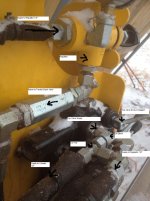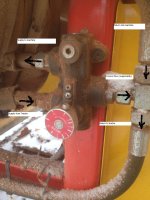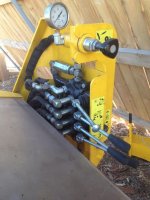Energy that is created (by the pump) and not used (somewhere in your system) will generate excessive heat. Unless this machine was homemade by Bubba, then I am sure even a fresh out of college engineer could determine total BTU output of the system and then size a cooling system sized appropriately with contingency. As long as everything is working as it was designed.
Maybe this can help finding your problem...
How long have you had this machine? I ask because it looks new.
Has it just started doing this or has it always done it since you got it?
What does it do?
Does it have its own engine or does it require you to use your tractor's PTO to drive the pump?
Do you have the hydraulic schematics? Can you post them?
Did the manufacturer give you a list of what all relief valves and regulators should be set to?
What type of cooler does it have? Does it have a fan blowing over the coils?
Are you sure the cooler is working and clean? You should be able to feel a difference between incoming and outgoing oil though the cooler.
Are there any filters installed? Does your manual state whether or not they have differential reliefs in them?
Maybe this can help finding your problem...
How long have you had this machine? I ask because it looks new.
Has it just started doing this or has it always done it since you got it?
What does it do?
Does it have its own engine or does it require you to use your tractor's PTO to drive the pump?
Do you have the hydraulic schematics? Can you post them?
Did the manufacturer give you a list of what all relief valves and regulators should be set to?
What type of cooler does it have? Does it have a fan blowing over the coils?
Are you sure the cooler is working and clean? You should be able to feel a difference between incoming and outgoing oil though the cooler.
Are there any filters installed? Does your manual state whether or not they have differential reliefs in them?
Last edited:



